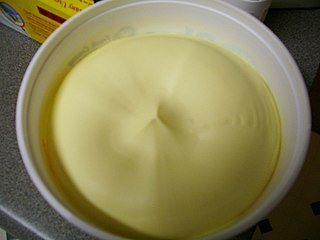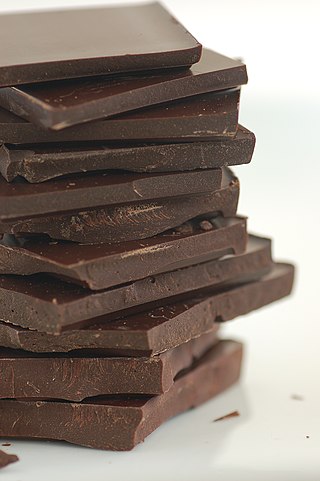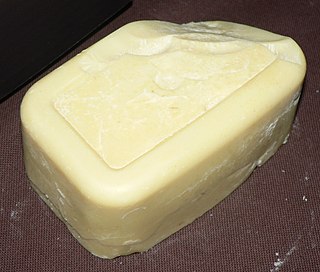| Commission v Italy | |
|---|---|
 | |
| Court | European Court of Justice |
| Citation(s) | (2003) C-14/00 |
| Keywords | |
| Free movement of goods | |
Commission v Italy (2003) C-14/00 is an EU law case, concerning the free movement of goods in the European Union.
| Commission v Italy | |
|---|---|
 | |
| Court | European Court of Justice |
| Citation(s) | (2003) C-14/00 |
| Keywords | |
| Free movement of goods | |
Commission v Italy (2003) C-14/00 is an EU law case, concerning the free movement of goods in the European Union.
An Italian rule limited the name ‘chocolate’ to products without vegetable fats. Those with vegetable fats, mainly British, Irish, and Danish chocolate, were made to label themselves ‘chocolate substitutes’. The Commission argued this breached Directive 73/241, passed under what is now article 115 TFEU, where article 1 said cocoa and chocolate products mean those in Annex 1, within minimum cocoa content to be described as chocolate. It also argued it infringed TFEU article 34, as the word ‘substitute’ devalued the good. Italy, under point 7(a) of the Annex said the free movement clause only applied to products without vegetable fats.
The Court of Justice held that the requirement was contrary to article 34. Under the Directive, the UK, Ireland, Denmark could authorise manufacturers to add vegetable fats to chocolate made there, but it could not benefit from the free movement clause. TFEU article 34 applied to obstacles to marketing products. The Italian rule would make British producers adjust their products and incur additional packaging costs. The Italian law had to be justified by a mandatory requirement, and steps must be proportionate. On the facts, the addition of vegetable fat did not substantially modify the product. So a ‘neutral and objective statement’ informing consumers would be enough. Obliging a change of the sale name was going further than necessary to protect consumers.
82 It is therefore important to ascertain whether the addition to cocoa and chocolate products of vegetable fats other than cocoa butter substantially alters their composition, so that they no longer present the characteristics expected by consumers buying products bearing the name chocolate and that a label providing appropriate information as to their composition cannot be considered sufficient to avoid confusion in the minds of consumers.
83 The characteristic element of cocoa and chocolate products within the meaning of Directive 73/241 is the presence of a certain minimum cocoa and cocoa butter content.
84 In particular, it should be recalled that, in accordance with point 1.16 of Annex I to Directive 73/241, products meeting the definition of chocolate within the meaning of the directive must contain a minimum total dry cocoa solids content of 35%, with at least 14% of dry non-fat cocoa solids and 18% of cocoa butter.
85 The percentages set by Directive 73/241 are minimum contents which must be complied with by all chocolate products manufactured and marketed under the name chocolate in the Community, independently of whether the legislation of the Member State of production authorises the addition of vegetable fats other than cocoa butter.
86 In addition, it must be pointed out that, since Directive 73/241 explicitly permits Member States to authorise the use, in the manufacture of cocoa and chocolate products, of vegetable fats other than cocoa butter, it cannot be claimed that the products to which those fats have been added, in compliance with that directive, are altered to the point where they no longer fall into the same category as those which do not contain such fats.
87 Therefore, the addition of vegetable fats other than cocoa butter to cocoa and chocolate products which satisfy the minimum contents required by Directive 73/241 cannot substantially alter the nature of those products to the point where they are transformed into different products.
88 It follows that the inclusion in the label of a neutral and objective statement informing consumers of the presence in the product of vegetable fats other than cocoa butter would be sufficient to ensure that consumers are given correct information.
89 In those circumstances, the obligation to change the sales name of those products which is imposed by the Italian legislation does not appear to be necessary to satisfy the overriding requirement of consumer protection.

Chocolate or cocoa is a food made from roasted and ground cacao seed kernels that is available as a liquid, solid, or paste, either on its own or as a flavoring agent in other foods. Cacao has been consumed in some form since at least the Olmec civilization, and later Mesoamerican civilizations also consumed chocolate beverages before being introduced to Europe in the 16th century.

Nutella is a brand of brown, sweetened hazelnut cocoa spread. Nutella is manufactured by the Italian company Ferrero and was introduced in 1964, although its first iteration dates to 1963.

Margarine is a spread used for flavoring, baking, and cooking. It is most often used as a substitute for butter. Although originally made from animal fats, most margarine consumed today is made from vegetable oil. The spread was originally named oleomargarine from Latin for oleum and Greek margarite. The name was later shortened to margarine.

European Union law is a system of rules operating within the member states of the European Union (EU). Since the founding of the European Coal and Steel Community following World War II, the EU has developed the aim to "promote peace, its values and the well-being of its peoples". The EU has political institutions, social and economic policies, which transcend nation states for the purpose of cooperation and human development. According to its Court of Justice the EU represents "a new legal order of international law".

Milk chocolate is a form of solid chocolate containing cocoa, sugar and milk. It is the most consumed type of chocolate, and is used in a wide diversity of bars, tablets and other confectionery products. Milk chocolate contains smaller amounts of cocoa solids than do dark chocolates, and contains milk solids. While its taste has been key to its popularity, milk chocolate was historically promoted as a healthy food, particularly for children.

A chocoholic is a person who craves or compulsively consumes chocolate. The word "chocoholic" was first used in 1968, according to Merriam-Webster. It is a portmanteau of "chocolate" and "alcoholic". The term is used loosely or humorously to describe a person who is inordinately fond of chocolate; however, there is medical evidence to support the existence of actual addiction to chocolate. Psychoactive constituents of chocolate that trigger a ‘feel-good’ reaction for the consumer include tryptophan and phenylethylamine, which may contribute to cravings and addiction-like responses, particularly in people with specific genetic alleles. The quantity of sugars used in chocolate confections also impacts the psychoactive effects of chocolate.

Cocoa butter, also called theobroma oil, is a pale-yellow, edible fat extracted from the cocoa bean. It is used to make chocolate, as well as some ointments, toiletries, and pharmaceuticals. Cocoa butter has a cocoa flavor and aroma. Its melting point is slightly below human body temperature. It is an essential ingredient of chocolate and related confectionary products.

White chocolate is a confectionery typically made of sugar, milk, and cocoa butter, but no cocoa solids. It is pale ivory in color, and lacks many of the compounds found in milk, dark, and other chocolates. It is solid at room temperature because the melting point of cocoa butter, the only white cocoa bean component, is 35 °C (95 °F).

Reese's Take 5 is a candy bar that was released by The Hershey Company in December 2004. The original name of the candy bar was TAKE5 but common usage among consumers added a space. In June 2019, when the candy bar became part of the Reese's family, the name was officially changed to Reese's Take 5.

The European single market, also known as the European internal market or the European common market, is the single market comprising mainly the 27 member states of the European Union (EU). With certain exceptions, it also comprises Iceland, Liechtenstein, and Norway and Switzerland. The single market seeks to guarantee the free movement of goods, capital, services, and people, known collectively as the "four freedoms". This is achieved through common rules and standards that all participating states are legally committed to follow.

Couverture chocolate is a chocolate that contains a higher percentage of cocoa butter (32–39%) than baking or eating chocolate. This additional cocoa butter, combined with proper tempering, gives the chocolate more sheen, a firmer "snap" when broken, and a creamy mellow flavor.

Compound chocolate is a product made from a combination of cocoa, vegetable fat and sweeteners. It is used as a lower-cost alternative to pure chocolate, as it uses less-expensive hard vegetable fats such as coconut oil or palm kernel oil in place of the more expensive cocoa butter. It may also be known as "compound coating" or "chocolatey coating" when used as a coating for candy. It is often used in less expensive chocolate bars to replace enrobed chocolate on a product.
Mango oil, mango kernel fat, or mango butter, is an oil fraction obtained during the processing of mango butter. Mango oil is a seed oil extracted from the stone of the mango, the fruit of the Mangifera indica tree. The oil is semi-solid at room temperatures, but melts on contact with warm skin, making it appealing for baby creams, suncare balms, hair products, and other moisturizing products. The oil is a soft yellow color with a melting point of 32–42 °C (90–108 °F).

Chocolate is a food product made from roasted and ground cocoa pods mixed with fat and powdered sugar to produce a solid confectionery. There are several types of chocolate, classified primarily according to the proportion of cocoa and fat content used in a particular formulation.

Hershey Kissables were a chocolate candy sold by The Hershey Company from 2005 to 2009. Comparable to M&M's, Hershey Kissables were shaped like miniature Hershey's Kisses and were coated in a thick sugar shell.

Dry cocoa solids are the components of cocoa beans remaining after cocoa butter, the fatty component of the bean, is extracted from chocolate liquor, roasted cocoa beans that have been ground into a liquid state. Cocoa butter is 46% to 57% of the weight of cocoa beans and gives chocolate its characteristic melting properties. Cocoa powder is the powdered form of the dry solids with a small remaining amount of cocoa butter. Untreated cocoa powder is bitter and acidic. Dutch process cocoa has been treated with an alkali to neutralize the acid.

Chocolate bloom is either of two types of whitish coating that can appear on the surface of chocolate: fat bloom, caused by changes in the fat crystals in the chocolate; and sugar bloom, due to crystals formed by the action of moisture on the sugar. Fat and sugar bloom damage the appearance of chocolate but do not limit its shelf life. Chocolate that has "bloomed" is still safe to eat, but may have an unappetizing appearance and surface texture. Chocolate bloom can be repaired by melting the chocolate down, stirring it, then pouring it into a mould and allowing it to cool, bringing the sugar or fat back into the solution.
The following outline is provided as an overview of and topical guide to chocolate:

The cioccolato di Modica is an Italian P.G.I. specialty chocolate, typical of the municipality of Modica in Sicily, characterized by an ancient and original recipe using manual grinding which gives the chocolate a peculiar grainy texture and aromatic flavor. As prodotto agroalimentare tradizionale, it is a specialty officially recognized by the Italian Ministry of Agriculture, Food and Forestry Policies. Modica chocolate is made "cold" according to a traditional recipe and is not conched.

RWE Vertrieb AG v Verbraucherzentrale Nordrhein-Westfalen eV (2013) C-92/11 is an EU law and consumer protection case, concerning the Unfair Terms in Consumer Contracts Directive. It emphasises the foundations of consumer protection on inequality of bargaining power and imbalances in information.